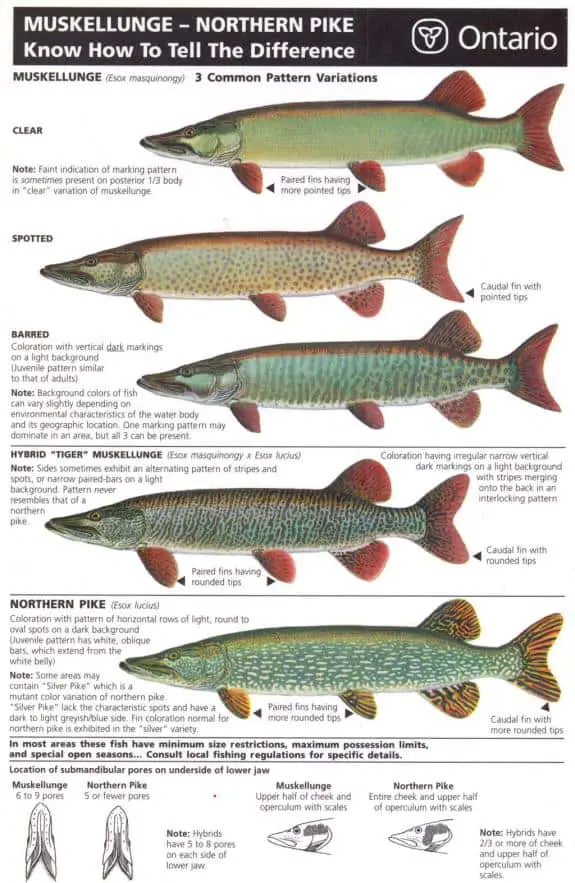The muskellunge (aka “musky” or “muskie”) is one of the really amazing freshwater fish, especially up north, and the bane of many a devoted angler’s existence.
Telling a tiger muskie apart from a muskie is a little bit harder than telling a northern pike and regular muskie apart.
Tiger muskie can look mostly like a muskie with some pike characteristics or a pike with some muskie characteristics. While appearances can vary, two classic giveaways are dark green coloration with vertical line patterns, or dark spots and lines on a light background color.
Telling Tiger Muskies & Muskies Apart
Some anglers have noted that one fish can look more like a “tiger pike” than a “tiger muskie” but a hybrid of the northern pike and muskellunge go by the name of tiger musky regardless of which parent fish they are closer in appearance to.
For example, take a look at these four pictures of tiger musky (copyright information below):
Picture Copyrights (from top right to bottom left):
- Copyright Jeff Van Remortel – https://www.youtube.com/watch?v=6rStqnJ5hK8&ab_channel=JeffVanRemortel
- Copyright Musky Mastery – https://www.youtube.com/watch?v=ledPE5N7zAE&ab_channel=MuskyMastery
- Public Domain from the U.S. Army Corps of Engineers
- Tiger Muskie 1 By BenitoJuarez98 – Own work, CC BY-SA 4.0, https://commons.wikimedia.org/w/index.php?curid=46011085
You know what really jumps out here? How different some of these fish look from each other, and this is a pretty non-diverse sample size. Throw in a dozen musky pictures and some pike or pike-pickerel hybrids and it’s easy to see how it gets confusing telling one from another.
So How Are You Supposed to Tell a Tiger Muskie from a Pike or Muskie?
- Any fish with “dual” patterns of pike and muskie. Only tiger muskie can have both on the same fish
- Reverse coloration – tiger muskie often have dark markings on a light background, the opposite coloration of a pike so if they have the colors or patterns of a pike but with reverse coloration, it’s likely a tiger muskie
- Head size – Even on the biggest muskie or pike the head is about 1/3 the size of the body. On tiger muskie the head is about 1/2 the size of the body
- Irregular spots/stripes – Tiger muskie can have patterns that seem to start spotted then go striped, or vice-versa, or even mix the two across the body. That’s a give away it’s a hybrid
- Rounded fins – If the fish clearly shows many characteristics of a muskellunge but has the rounded fins of a pike, then you’re dealing with a tiger musky
If you look for these characteristics you will be able to more quickly and accurately make an ID and tell if your fish is a muskie, or the even rarer and harder to catch tiger muskie.

Just What Is a Tiger Muskie?
A tiger muskie isn’t an actual sub-species but a hybrid. This is the fish that occurs when a muskellunge and a northern pike mate. A tiger muskie can’t breed as a result, so they are much rarer than even their musky cousins.
In fact, in most places where tiger muskie are found they are stocked after having been bred/created in hatcheries. The tiger musky can occur naturally, but they are even rarer to find than the muskie which makes this a really unusual situation.
In many areas tiger muskies are all catch and release to keep the population healthy, so keep that in mind to do you research prior to fishing any water where you might run into these amazing fish.
Most come from hatcheries
Cross breeding occurs in the wild once in a while between a pike and musky, but like most hybrids in nature tiger musky are sterile. That means having large numbers of these fish means the need for hatchery breeding to increase the numbers that would actually be much, much lower when they occur naturally.
Anglers are pretty okay with this because the tiger musky grows faster than even the regular northern pike and musky and have a reputation for still being very aggressive (maybe even more so) and put up just as impressive a fight.
What’s the Difference Between a Musky and Tiger Muskie?
Beyond the appearance differences that we’ve already gone over in-depth, with another great identification resource below, the big differences between the musky and tiger musky really tell you a lot about these fish.
The musky is the natural member of the Esox family. It takes one musky and one northern pike to actually breed to create this hybrid (usually a male pike that avoids getting eaten with a roughly same sized musky).
What else sets tiger musky apart from musky?
- Muskies can breed, tiger muskies can’t.
- Tiger musky tend to grow much faster, reaching some pretty crazy sizes in half the time of the already fast growing musky
- Tiger musky are even harder to catch than musky, which are already known as “the fish of 10,000 casts.”
Now you know how to thoroughly answer the question of “What is the difference between a muskie and tiger muskie?”
Great Video on Tiger Muskie Fishing Tips
If you’re needing a little bit more to help look at picture identification guides for tiger musky to help bring home what these differences in appearance actually look like, then make sure to check out the resource below for some review.
One of the best visual representations I’ve seen of musky vs tiger musky vs northern pike can be found HERE.
While it might not be convenient to bring that up on a lake, it’s a good visual example to study the traits of these fish and further figure out in your head what to look for with each species.
In Conclusion
Any time you’re going for big pike, big musky, or big tiger musky then chances are you’re going to be hitting the same bodies of water. You’ll also likely get many more hits from pike before hitting those big musky, but that’s part of the fun!
I’ve never heard of someone complaining about a day of good pike fishing (as long as the pike weren’t snakes) so if that’s the worst that happens that’s a really good day.
If you have a day of angling where you need to tell a big musky apart from a big tiger musky, then you are having a GREAT day! Happy fishing!




